With a plot thinner than a starving moggie, Cats is showing its age
By Joyce Morgan, John Shand and Peter McCallum
THEATRE
CATS
Theatre Royal
June 20. Until September 6
Reviewed by JOYCE MORGAN
★★★
This show has had more lives than the proverbial cat.
Since first pouncing onto the stage in 1981, it has become one of the longest running musicals on the West End and Broadway.
Performed around the world since, it’s barely taken a catnap. Now those cats with the amber eyes are back in Sydney for the start of a national tour, 40 years after the musical was first staged here.
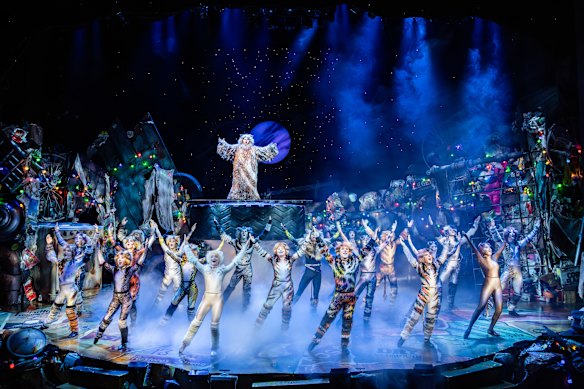
Cats is a series of party pieces.Credit: Daniel Boud
There’s been little attempt to update this production by the show’s originators – composer Andrew Lloyd Webber, director Trevor Nunn, choreographer Gillian Lynne and designer John Napier.
The musical is based on TS Eliot’s Old Possum’s Book of Practical Cats, a collection of light-hearted verses the poet wrote for his godchildren.
The show is strong on movement and physicality, from the moment the junkyard cats emerge from the moonlit shadows.
But the plot is thinner than a starving stray. A cat tribe assembles once a year to celebrate and decide who will journey to Heaviside Layer, a kind of moggy heaven.
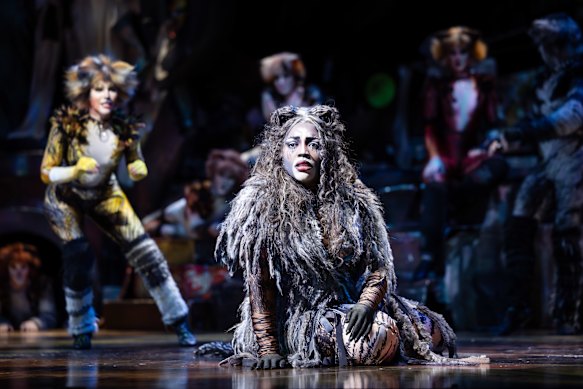
Gabriyel Thomas was a strong presence in the key role of Grizabella.Credit: Daniel Boud
With minimal plot, character development or conflict, the show is a series of party pieces in which various cat characters get a chance to shine.
Some shine brightly. Todd McKenney was terrific as fatcat Bustopher Jones in a costume redolent of Aunty Jack.
McKenney’s dual role as Gus, the ageing performing cat, provided one of the night’s rare affecting interludes as he recalled his glory days in a moving duet with Lucy Maunder (Jellylorum). This lifted the second act opening after a first act that became bogged down with the overlong Jellicle Ball dance section.
A sexy Rum Tum Tugger (Des Flanagan) rose to his rock star moment. Mark Vincent as Old Deuteronomy brought sonorous gravitas to the role of the tribal elder – no mean feat given he looked like a Womble.
Gabriyel Thomas was a strong presence in the key role of Grizabella, the former glamour puss, now more grizzled than bella, who has been rejected by the tribe. With her rich, powerful voice, Thomas invests with pathos the showstopper Memories.
Jemima (Ella Fitzpatrick) delivered a couple of teasers of the show’s best-known song earlier in the piece, but a lack of vocal strength and brittle tone did not serve well the sweeping melody.
The energetic ensemble worked hard as they danced and pranced on and occasionally off the stage and into the auditorium. Yet much of the choreography and movement feels dated.
Whether it was sound balance or delivery, the lyrics to the ensemble vocal numbers were difficult to determine.
The off-stage orchestra, under musical director Paul White, was well paced and versatile in numbers that ranged across jazz, blues and pop to anthemic and operatic.
Cats was ground-breaking when it premiered, an immersive spectacle that helped usher in an era of mega-musicals.
Since then, the big-budget musicals it helped spawn have become increasingly sophisticated.
There may be nostalgic appeal in revisiting a work that feels rooted in an ’80s era and aesthetic. So thanks for the Memories. But today these frolicking felines feel whiskery.
THEATRE
KOREABOO
Belvoir Downstairs Theatre, June 19
Until July 20
Reviewed by JOHN SHAND
★★★
Soon Hee never held her baby before she was taken away for adoption; she saw only her tiny pink feet retreating in the nurse’s arms. She had become pregnant outside of wedlock, which, if discovered, would bring such shame on her family, and people would shun the little Seoul shop run by her mother.
The pink feet belonged to a girl christened Hannah by her adoptive Australian parents. She was a young woman before she sought out her birth mother, and now she’s back in Seoul a second time to – what? Heal a wound? Form a bond? Discover her inner Korean self?
“Koreaboo”, Michelle Lim Davidson explains in a preface to her play (here having its world premiere), is a pejorative term describing someone (usually non-Korean) obsessed with Korean culture.
The set-up to Davidson’s play is autobiographical, and potentially implicit in any such forced separation is deep scar tissue. But rather than milking tears, the playwright is more intent upon teasing out the laughs as Hannah tries to find a place in Soon Hee’s world.
Jessica Arthur’s Griffin Theatre Company production has Davidson, herself, playing Hannah, and Heather Jeong (best known as a TV chef) playing her mother. Mel Page’s set realises Davidson’s vision of a Seoul convenience store, complete with noodles, toilet paper and an imposing pyramid of Spam tins.
This is Soon Hee’s domain, and an Australian invasion is not especially welcome, not only because any scar in Soon Hee’s heart has long been impenetrable, but because Hannah, keen to help, will just drive customers away with her hopeless command of Korean.
Jeong excels as the brutally honest Soon Hee, telling Hannah they look more like sisters than mother and daughter. She is exceptional at making the shop her castle and at raising the drawbridge against her daughter – not cruelly, but in a brusque, pragmatic way. Nonetheless, she makes us like Soon Hee because we see through the act from the start and we admire her stoicism and even her goofy obsessions with gnomes, Sex and the City and K-pop – notably in its TV talent quest guise of Star Power.
Davidson’s performance is more problematic, and perhaps she shouldn’t have been cast in her own play. As accomplished as we know she is as an actor, she can’t locate the same truth in playing Hannah as she did in writing the role. The performance becomes one-dimensional – Hannah the anguished victim – and so wooden that her hands barely cease to dangle by her thighs.
Writing the play should have been enough. It’s good, quirky work that doesn’t seek to dot the “i” or cross the “t” in complexity, but lets it simmer in the background. An actor who was not partially playing herself might have stormed into the role, made Hannah her own and trusted the words rather than being shy of finding the character’s core both vocally and physically.
MUSIC
Lang Lang and the Sydney Symphony.
Opera House. June 18
Reviewed by PETER McCALLUM
★★★½
Lang Lang began the Bach-like improvisatory solo at the start of Saint-Saens’ Piano Concerto No. 5 with ponderous spaciousness before accelerating to three declamatory chords held back as though announcing the day of judgment.
To me, the spaciousness was overdone, taking the wind from the sails with a resulting loss of tension, but Lang Lang kept a hold over many in the sold-out hall through a faux-majestic bearing, swashbuckling velocity and thunderous volume.
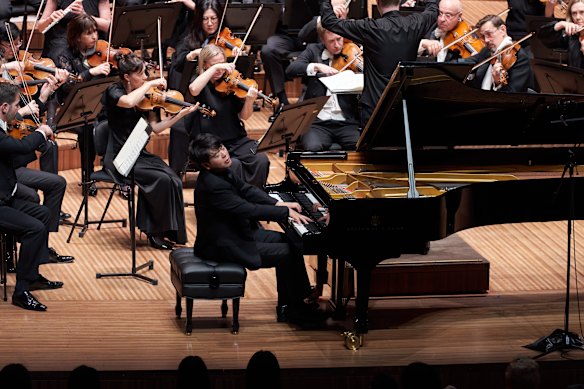
Lang Lang performing with the Sydney Symphony Orchestra.Credit: Jay Patel/Sydney Symphony Orchestra
Lang Lang dominated the music throughout, pushing the tempo ahead at whim. Conductor Benjamin Northey faithfully stayed with him, even if, at times, the orchestra was left scurrying attentively to meet the needs of an overbearing general rather than participating as equals.
When the second movement reached the second theme, which leaps with playful daring from the cellos, Lang Lang thumped out the vamping accompaniment with grotesquerie like a cartoon-like caricature so that the cello theme could barely be heard.
He did, however, lower the volume to a lighter touch when it was the piano’s turn to play it.
The Presto finale was written with such virtuosic impetuosity in mind, and Lang Lang played the main theme with daredevil brilliance. When Saint-Saens quietens this for a chorale on the woodwind, the composer gives the piano shady trill motives marked “always pianissimo” but in this performance they were never so and drowned out the chorale. Lang Lang remains a consummate showman but one didn’t feel he was listening closely to the orchestra or focused on realising the composer’s musical intentions.
The first half was also devoted to French music and began with a delightful rarity, D’un Matin de printemps (Of a Spring Morning) by Lili Boulanger. Boulanger’s spring morning dances with light energy and freshness, and Northey brought out small details of orchestration with care to produce a texture in a state of constant renewal.
Boulanger, who died aged 24, had the rare ability to create a sense of magic, sparkle and frisson. Northey and the SSO followed this with a work of kindred sensibility, La Mer by Claude Debussy, who died in the same year, 1918, aged 55.
The SSO’s clarity and discipline and Northey’s attention to detail were again welcome, although this occasionally inhibited the build-up of momentum and tension in the first two movements. The third was buffeted with surging gestures, closing with an energised blaze of magnificence.
MUSIC
Aphrodite
Sydney Chamber Opera in association with Omega Ensemble
Carriageworks, June 20
Reviewed by PETER McCALLUM
★★★½
Aphrodite, the fourth opera by American composer Nico Muhly, is a parable of women’s relationship to beauty, mixing mythology with the internet age, sometimes quizzically, sometimes wistfully.
Librettist Laura Lethlean places the central paradox in the character of a successful academic and documentary maker, Ava (Jessica O’Donoghue), who observes others dispassionately but is unable to apply her expertise on what she calls “the Aphrodite complex” to her own situation.
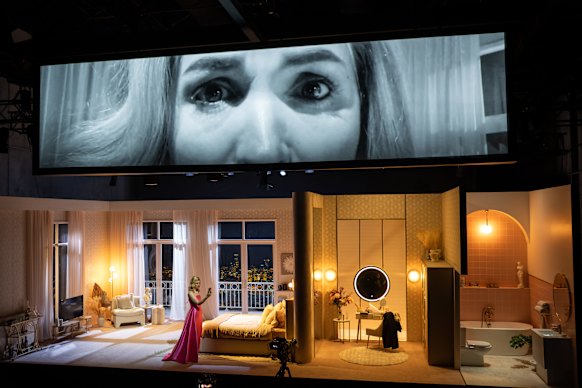
The set is a hotel room with a video screen above.Credit: Daniel Boud
After spiralling into alcohol-fuelled melancholy, she is confronted by her doppelganger, the mythical Aphrodite (Meechot Marrero) who, before a mirror, promises to teach her to be “eternally desirable in a world that is insatiable”.
Designer Isabel Hudson’s set is a hotel room and, against the glittering cityscape outside, a video screen above captures cold voyeuristic images of Ava’s body in disconcerting TV-style monochrome (video design Morgan Moroney). Symbolising the arrival of some kind of self-knowledge, director Alexander Berlage finally moves the characters outside the frame and, in a dramatic moment, the video link is severed.
O’Donoghue is statuesque and tortured as Ava and sustains the central role throughout with an unwaveringly bright, well-moulded and finished sound (though I prefer her voice unamplified). Muhly gives her gently rhapsodic lines as she sings of Aphrodite’s triumph over the golden apple in the judgment of Paris leading to the Trojan wars.
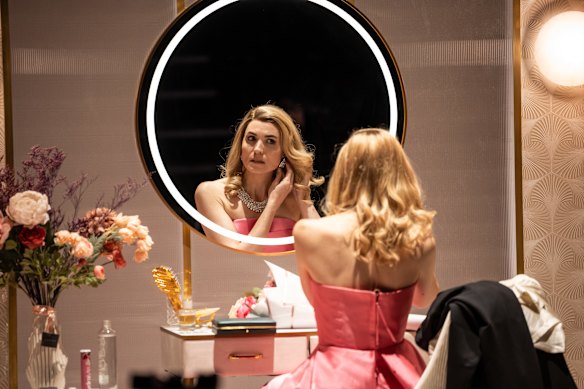
Jessica O’Donoghue is statuesque and tortured as Ava.Credit: Daniel Boud
This narration is interspliced with Ava’s reflections on her attraction during a recent documentary filming to a cameraman “Hector” (who in mythology was Helen of Troy’s brother-in-law, although I wasn’t sure if the significance of this extended beyond a witty classical reference).
Marrero’s voice is warm and intense as though to exclude self-doubt, and Muhly initially gives her angular, modernist music. The dichotomy of Ava’s languorous melodies (including romantic ballads) and Aphrodite’s spikiness brought welcome contrast and, in a score that tended towards sentimentality, could possibly have been exploited further.
Nevertheless, Muhly injected variety in a series of instrumental interludes played by the Omega Ensemble that mixed rhythmic activity with lyricism. Conductor Jack Symonds coordinated singers and instrumentalists with discerning balance and precision.
This is not the first operatic treatment of the declining relevance that accompanies ageing beauty and gives a TikTok twist to a theme explored in Strauss’s Der Rosenkavalier and Britten/Mann’s Death in Venice. In that context, Muhly and Lethlean’s resolution – end the pageantry of tawdry beauty and “close your eyes” – was inconclusive and this may well have been the intention.
As a cameo, this piece is promising though it might benefit from revision that tightened the trajectory, sharpened the edge and perhaps created a greater musical transformation when the action moves out of the frame and into self-insight.
MUSIC
Lang Lang in Recital
Sydney Opera House Concert Hall, June 22
Reviewed by PETER McCALLUM
★★★½
Lang Lang’s sold-out solo recital in the Opera House Concert Hall focused on eccentric and poetic aspects of 19th century Romantic composers, Schumann’s volatile and at times wild set, Kreisleriana, drawing its inspiration from the fantasy world of writer E. T. A Hoffman, and a selection of 12 mazurkas by Chopin, those elusive gems that seem to both express and repress Chopin’s love for the homeland he forsook.
Lang Lang takes great liberties with rhythm, tempo and loud/soft dynamics. However, even in music in which such features are part of the performance style, these were sometimes overdone and based more on personal whim than logic or expressive imperatives.
Before embarking on these two sets, he began with Faure’s beautiful Pavane, Opus 50, in an arrangement for piano, the tone quiet and misty except for some bass rumblings towards the end.
The first piece of Kreisleriana was extremely fast, as indeed Schumann intended. Although the metre and rhythm was unclear in Lang Lang’s realisation, his approach did bring out the manic quality of the piece that was surely part of the expressive intent.
By contrast, the second, which constantly changes in mood and pace, was drawn out and meandered from its dreamy opening theme through livelier sections in a more restrained mania. The fourth piece exaggerated these changes even further, though the rhythmic basis of the floating opening theme was lost in the process.
Lang Lang had a similarly indulgent approach to rhythm and tempo in the mazurkas in the second half, often varying the speed greatly from one phrase to the next. Although this style of playing drew attention to the expressive dimension, there were times when it undermined the dance-like basis of the pieces and replaced their simple eloquence with mannerism.
In the haunting Mazurka in A minor, Opus 17, no.4, Lang Lang’s rubato (literally “robbed time”, that is, rhythmic flexibility) suppressed the feeling of three in a bar to create a veiled sound that faded to nothing at the close. Although the focus of his selection was on quiet melancholy, he closed with the energetic Mazurka in F sharp minor Opus 59, No. 3, giving its heel-kicking rhythms a flamboyant swagger.
It was at moments such as this that the audience became fully attentive, and during the applause that followed, Lang Lang faced a wall of phone cameras, the use of which the ushers had struggled valiantly to suppress, though not always successfully.
The final work, Chopin’s Polonaise No. 5 in F sharp minor, Opus 44, continued the flamboyance (and key) of the final mazurka, in an unabashed display of pomp and crowd-pleasing bravura.
MUSIC
Baroque Unleashed
Australian Brandenburg Orchestra
City Recital, June 18
Reviewed by PETER McCALLUM
★★★
The concerto, a piece for a virtuosic soloist, or group of soloists, and orchestra, is among the most enduring legacies of the baroque era. It gratifies both collective and individual aspirations and it may be no coincidence that the scope and expressive power of the concerto continued to grow as democratic government and human rights became fundamental to societal organisation.
But that would be getting ahead of ourselves. For the Italian concertos of the 18th century that made up the Australian Brandenburg Orchestra’s program, it was sufficient for the soloist to demonstrate enough skill and grace to be noticed and admired but not so much as to appear to dominate.

Australian Brandenburg Orchestra concertmaster Shaun Lee-Chen. Credit: Supplied
Oboist Adam Masters struck this balance adroitly in Albinoni’s Concerto for oboe in D minor, Opus 9 No. 2, playing with a natural, unrushed and undistorted sense of accent and giving each phrase natural shape and liveliness.
In the famous slow movement, the adagio, for which this composer is best known, he held the soloist’s opening note with penetrating sweetness against undulating string arpeggios.
Corelli’s Concerto Grosso in D major, Opus 6, No. 4, which opened the concert, began with explosive chords, and in these conductor Paul Dyer aimed for expansiveness by allowing generous rests between them.
In the allegro section of the first movement, concertmaster Shaun Lee-Chen and Ben Dollman, principal second violinist, established a very rapid pace that at times risked becoming a furious dash.
For Pergolesi’s Concerto for Violin in B flat major, Lee-Chen separated the opening phrases with a playful wink, subsequently decorating thematic material with long bows. He pushed forward briskly in virtuosic passages though sometimes at the expense of intonation.
In the third movement, some sequential passages threatened to go awry but Lee-Chen generally held them in check in the cadenza-like material. After an Introduttione by Locatelli and the Concerto Alla rustica for strings in G major by Vivaldi in the second half, Robert Nairn played Vivaldi’s Concerto for cello in C minor on the larger violone (a baroque double bass).
With agility and skill, Nairn overcame the cumbrous tendency of this instrument, articulating with some clarity despite the gut strings and low pitch of the instrument. It was like listening carefully to a soft, low-voiced sage with the expectation they will say something interesting.
For Vivaldi’s Concerto Grosso Mogul for violin in D major, Lee-Chen elaborated cadenzas in the outer movements with unabashed display, tossing off phrases insouciantly though not without hazards for pitch and tone. The second movement, a highlight, was an improvisatory recitative-style movement which Chen played with confidence and imaginative freedom, accompanied by delicate sensitivity by harp (Hannah Lane), guitar and theorbo (Tommie Andersson and Nicholas Pollock).